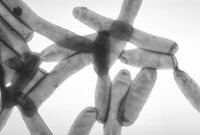Legionella pneumophila
| Legionella pneumophila | ||||||||||||||
|---|---|---|---|---|---|---|---|---|---|---|---|---|---|---|
 | ||||||||||||||
| Scientific classification | ||||||||||||||
| ||||||||||||||
| Binomial name | ||||||||||||||
| Legionella pneumophila |
Description and significance
Legionella pneumophila is a rod shaped, flagellated and a gram negative bacteria. L. pneumophila are aerobic and non-capsulated. It is known to be pathogenic to humans and leads to legionellosis or legionnaires’ disease. This species is determined to be the dominant human pathogen in its genus of 41 different species . It was first found to be pathogenic in 1976 when a group of men were found to be infected. It spread to more than 200 individuals and led to 34 casualties. It was first isolated by inoculation of a guinea pig with the blood sample of an infected person in 1947.
Genome structure
Cell structure and metabolism
Ecology
In general L. pneumophila can be found in aquatic environments worldwide.
Pathology
There are 41 different species in the genus Legionella and these are further divided into 64 serogroups. The serogroups 1, 4, and 6 are responsible for most human infections of legionnaires’ disease. Serogroup 1 is determined to be the cause of 70-90% of such infections.